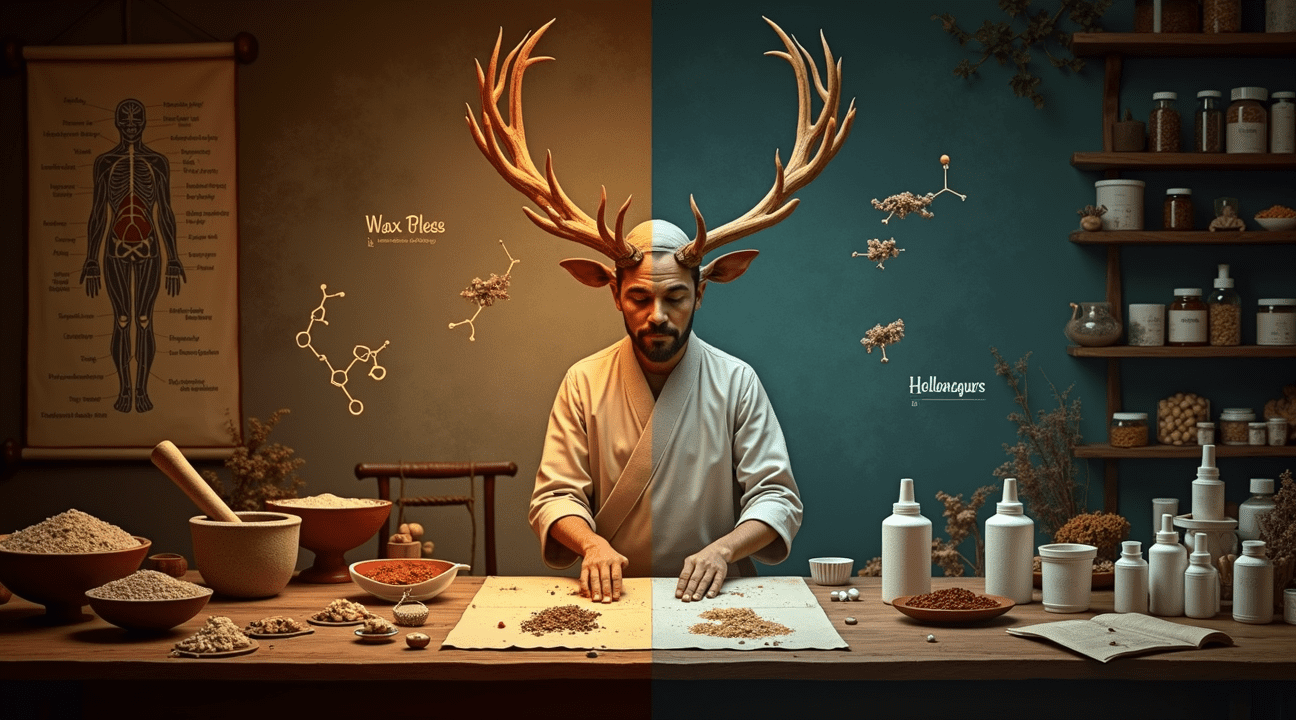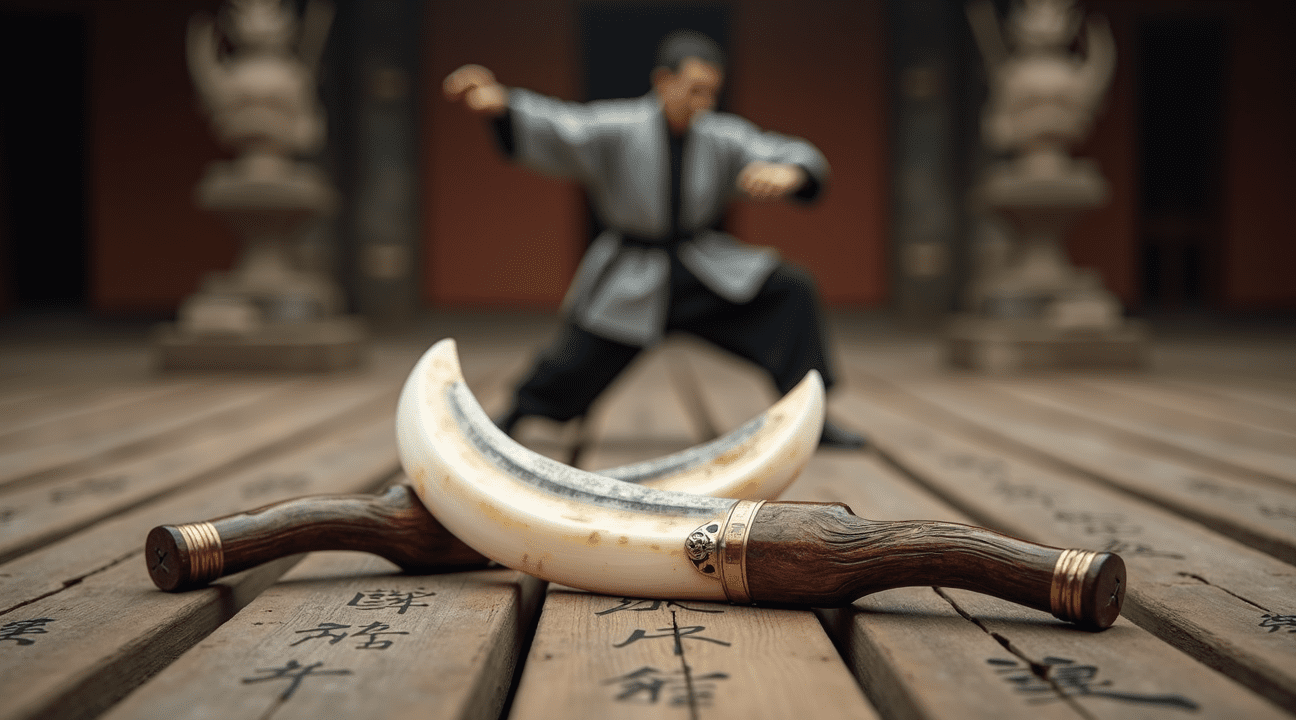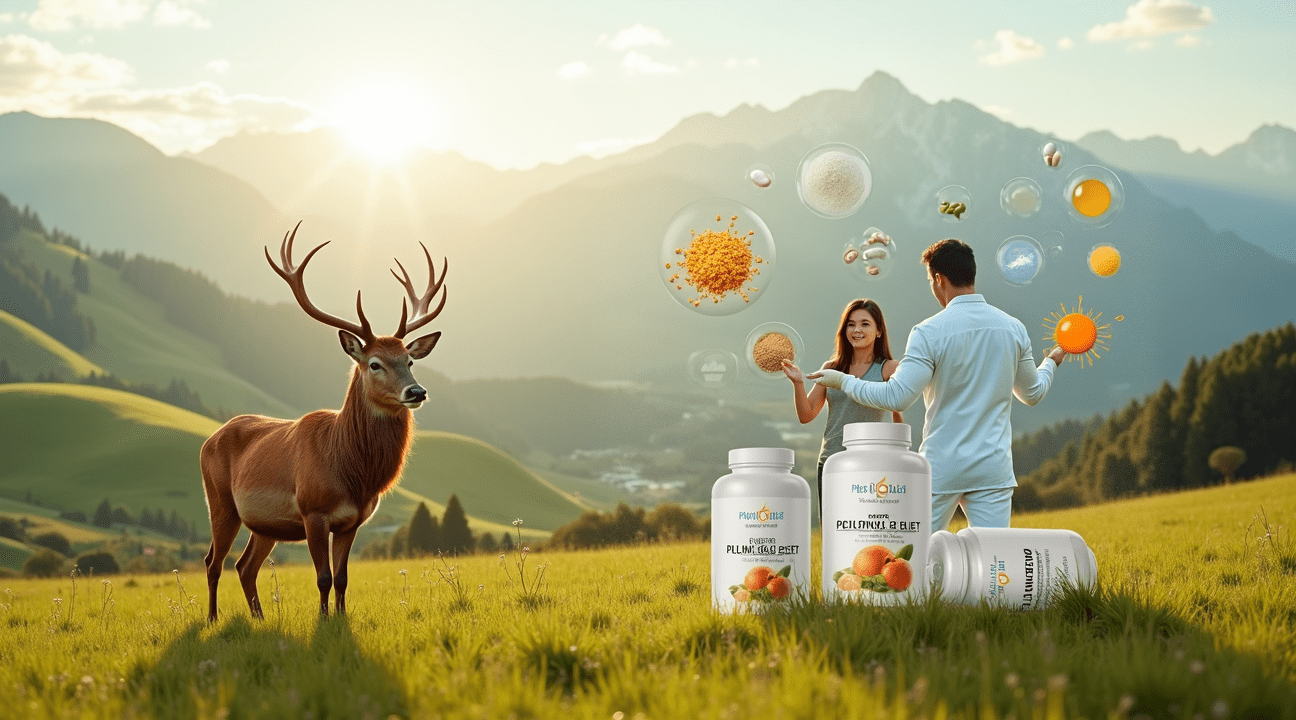Deer antlers have transformed from ancient healing remedies into a diverse array of modern applications. These natural structures now fuel industries ranging from health supplements to martial arts equipment and decorative crafts. The soft velvet that covers growing antlers has created particular value in recent decades. This material drives a substantial supplement market, with New Zealand leading global exports. The hard antler material itself provides raw material for furniture, tools, and specialized combat training equipment.
Key Takeaways
- Traditional medicine applications: Deer velvet has served Traditional Chinese Medicine for approximately 2000 years to address yang deficiency, joint health, and energy enhancement. Different antler sections target specific health concerns.
- Modern supplement industry: Deer antler velvet generates tens of millions in annual export revenue, particularly from New Zealand. These products are marketed for athletic performance, muscle recovery, and general wellness, although clinical evidence remains limited.
- Martial arts weapons: Deer horn knives are specialized training tools in Chinese martial arts. Their unique curved designs enable hooking motions and close-quarter combat techniques, while also aiding coordination and developing ambidextrous skills.
- Crafting and furniture applications: Antlers are valued for their natural branching structure, durability, and aesthetic appeal. They are used in the creation of chandeliers, lamp stands, tool handles, and artistic carvings.
- Regulatory considerations: Athletes may face sanctions due to IGF-1 content found in deer antler supplements. Additionally, the industry lacks standardized dosing and comprehensive clinical validation to support health-related claims.
From Ancient Medicine to Modern Performance Enhancement: How Deer Velvet Claims Stack Against Science
Deer velvet has captured attention across centuries, transitioning from ancient healing traditions to contemporary supplement shelves. Traditional Chinese medicine practitioners have long valued this soft, growing tissue from deer antlers as a powerful remedy for numerous health concerns. The substance continues to generate interest among athletes and health enthusiasts seeking natural performance enhancement options.
Traditional Claims and Modern Applications
Traditional Chinese medicine positions deer velvet as a versatile healing agent. Practitioners believe this substance can address male sexual dysfunction, anemia, and impotence while providing relief from arthritis and osteoporosis symptoms. TCM theory suggests deer velvet improves blood flow throughout the body, strengthens bones and muscles, and restores overall vitality in those experiencing decline.
Contemporary supplement manufacturers have expanded these traditional applications. Sports enthusiasts often turn to deer antler spray containing IGF-1 (Insulin-like Growth Factor-1) for muscle growth and recovery enhancement. Athletes believe this compound can accelerate healing after intense training sessions and improve overall performance metrics.
The supplement industry markets deer velvet as an adaptogen, claiming it helps the body manage stress and recover from illness more effectively. Proponents suggest regular consumption can:
- Boost immune system function
- Protect liver health
- Slow aging processes
- Control pain and reduce joint discomfort
- Improve mobility
Scientific Scrutiny and Regulatory Concerns
Modern clinical research paints a different picture than traditional claims suggest. Currently, no comprehensive clinical trials conclusively demonstrate deer velvet’s effectiveness for any specific health condition. This gap between traditional use and scientific validation raises important questions about supplement efficacy.
The presence of IGF-1 in deer antler products creates additional complexity. Sports organizations regulate IGF-1 as a performance-enhancing substance due to its potential for misuse in competitive athletics. Athletes who test positive for IGF-1 face sanctions, regardless of whether they consumed it through deer velvet supplements or synthetic sources.
Regulatory bodies haven’t established standardized dosing protocols for deer velvet products. Challenges associated with deer velvet supplements include:
- Inconsistent concentration of active compounds between manufacturers
- Quality control issues impacting supplement effectiveness
- Lack of scientific consensus on adaptogenic effects
The adaptogen classification presents its own challenges. While traditional medicine systems recognize adaptogenic properties in various substances, western science requires specific mechanisms of action and measurable outcomes. Smart technology might eventually help track physiological responses to adaptogenic supplements, but current measurement tools remain limited.
Consumers considering deer velvet supplements should understand the distinction between traditional use patterns and evidence-based medicine. Historical application doesn’t automatically translate to proven efficacy in controlled studies. Individual responses to supplements vary considerably, and what works for one person may produce different results in another.
Price points for high-quality deer velvet products often reflect the complex harvesting and processing requirements. Ethical sourcing adds another layer of consideration, as sustainable deer farming practices must balance animal welfare with commercial demands.
Healthcare providers frequently recommend discussing supplement use before beginning any new regimen. Drug interactions remain possible, particularly for individuals taking medications for blood pressure, diabetes, or hormone-related conditions. Some people experience digestive upset or allergic reactions when first introducing deer velvet products.
The supplement industry continues evolving as research methods improve and consumer awareness increases. Future studies may provide clearer insights into deer velvet’s potential benefits and optimal usage protocols. Until then, users must weigh traditional wisdom against current scientific limitations when making informed decisions about incorporating deer velvet into their health routines.
2000 Years of Traditional Applications: From Yang Deficiency to Western Supplements
Traditional Chinese Medicine practitioners have recognized deer antler products for approximately 2000 years as powerful remedies for yang deficiency syndromes. These ancient applications focused primarily on enhancing energy levels, supporting reproductive health, and strengthening joint function. Folk medicine traditions across various cultures have similarly embraced deer antler as a natural remedy for numerous health concerns.
Traditional Classification and Targeted Applications
Asian medicine systems categorize velvet antler into three distinct sections, each with specific therapeutic purposes. The Wax piece comes from the antler tips and practitioners traditionally recommend it for supporting children’s growth and development. The Blood piece represents the middle section and targets joint and bone health concerns. Finally, the Bone piece from the base addresses calcium deficiency and provides specialized care for elderly patients.
This systematic approach demonstrates how traditional medicine recognized different concentrations of beneficial compounds throughout the antler structure. Each section contains varying levels of growth factors, minerals, and bioactive compounds that align with specific health objectives.
Modern Research and Bioactive Components
Contemporary studies suggest deer antler may benefit several health conditions, including osteoarthritis, chronic fatigue, menstrual disorders, and cardiovascular health issues. Research attributes these potential benefits to the amazing feats of the antler’s complex composition, which includes essential amino acids, vital minerals such as calcium and zinc, specialized polypeptides, and high-quality collagen.
Scientists have identified these bioactive components as the likely mechanisms behind the traditional therapeutic claims:
- Amino acids support protein synthesis and tissue repair.
- Minerals like calcium and zinc contribute to bone density and metabolic function.
- Polypeptides may influence growth hormone pathways.
- Collagen provides structural support for joints and connective tissues.
Western countries now recognize deer velvet as a dietary supplement, though regulatory oversight varies by region. Manufacturers must comply with supplement regulations that govern quality, labeling, and safety standards. This regulatory framework ensures consumers receive products that meet established purity and potency requirements.
Common formulations include:
- Dried slices for steeping in hot water
- Powders for mixing into beverages or food
- Convenient pills for daily supplementation
- Liquid extracts for rapid absorption
- Topical sprays for localized application
- Traditional soups that combine multiple herbs
- Therapeutic ointments for external use
The versatility of these delivery methods allows individuals to choose formats that best suit their preferences and health goals. Capsules provide standardized dosing and convenience for busy lifestyles, while traditional preparations like soups maintain cultural connections to ancestral practices.
Practitioners often recommend starting with lower doses to assess individual tolerance before gradually increasing intake. They emphasize the importance of consulting healthcare providers, especially for individuals taking medications or managing chronic conditions. Quality sourcing remains critical, as innovative processing methods can significantly impact the final product’s potency and safety.
Modern supplement manufacturers employ various extraction and processing techniques to concentrate active compounds while preserving their biological activity. Freeze-drying, low-temperature processing, and specialized extraction methods help maintain the integrity of heat-sensitive components that contribute to therapeutic effectiveness.
The transition from traditional medicine to modern supplementation represents an evolution in how societies access and utilize these natural resources. While ancient practitioners relied on whole antler preparations, contemporary formulations offer standardized potencies and convenient delivery systems that fit modern lifestyles.
Research continues to explore the mechanisms behind traditional claims, with particular focus on joint health, energy metabolism, and hormonal balance. These ongoing studies may provide additional validation for historical uses while identifying new therapeutic applications for deer antler compounds.

Martial Arts Weapons: The Legacy of Deer Horn Knives in Combat Training
The dense, durable structure of deer antlers has carved out a distinctive place in Chinese martial arts through the creation of deer horn knives, also known as crescent moon knives or zhǎojiǎodāo. These unique weapons showcase how natural materials can evolve into sophisticated training tools that embody both practical combat applications and cultural significance.
Traditional vs Modern Construction Methods
Traditional deer horn knives crafted from natural antlers offer practitioners an authentic connection to centuries-old martial arts traditions. These weapons possess distinctive aesthetic qualities that modern alternatives struggle to replicate, featuring the natural grain patterns and organic curves that make each piece unique. However, traditional antler construction requires careful maintenance to prevent cracking and deterioration over time. The organic material also limits durability compared to contemporary alternatives, making these weapons more suitable for ceremonial purposes or light training rather than intensive combat practice.
Modern versions typically incorporate stainless steel construction while maintaining traditional designs that honor the weapon’s heritage. These contemporary interpretations offer superior durability and require minimal care, allowing practitioners to focus on technique development rather than weapon maintenance. Steel construction also enables more consistent weight distribution and balance across multiple weapons, which proves beneficial for training consistency and skill progression.
Combat Applications and Training Benefits
Deer horn knives allow for intricate offensive and defensive maneuvers that distinguish them from conventional martial arts weapons. The curved design enables practitioners to execute hooking motions, trapping techniques, and close-quarter combat strategies that straight blades cannot accommodate. These weapons challenge students to develop enhanced hand coordination and spatial awareness, as the unusual shape requires modified grip techniques and movement patterns.
The weapons symbolize heritage and martial skill within traditional Chinese fighting systems, particularly in styles like Praying Mantis Kung Fu and certain northern Chinese martial arts disciplines. Training with deer horn knives develops specific muscle memory for controlling curved weapons while improving overall dexterity and reaction time. The dual-weapon training format also enhances ambidextrous coordination, forcing practitioners to develop equal proficiency with both hands. These skills transfer effectively to other martial arts weapons and contribute to comprehensive combat training that extends beyond single-weapon specialization. Just as sports quote wisdom inspires athletic performance, the philosophical elements embedded in deer horn knife training motivate practitioners to pursue technical mastery while respecting martial arts traditions.
For a visual demonstration of deer horn knives in action, refer to the following video:
https://www.youtube.com/watch?v=FXvDSBRP6fA

From Furniture to Art: Creative Uses of Deer Antlers in Home and Craft
Deer antlers have found their way into countless homes and workshops as versatile materials for both functional items and artistic creations. Their natural branching structure and unique texture make them perfect for an impressive range of applications that combine rustic charm with practical utility.
Functional Furniture and Home Décor Applications
Artisans frequently transform deer antlers into stunning furniture pieces that serve as conversation starters in any room. Chandeliers crafted from antlers bring an organic elegance to dining rooms and living spaces, while their natural curves create dramatic lighting fixtures that cast interesting shadows. Many furniture makers also construct chairs using antler frames, combining the natural strength of the bone with traditional upholstery techniques.
Lamp stands represent another popular application, as the antler’s natural height and branching pattern provide excellent support for lampshades. Wall mounts showcase the antler’s natural beauty while serving as functional coat racks or hat displays. Smaller antler pieces work exceptionally well as curtain rods or towel holders in bathrooms with rustic themes.
Home decorators appreciate antlers for creating ornaments and seasonal displays. Their neutral coloring complements most interior design schemes, and their distinctive silhouette adds visual interest to mantels, shelves, and tabletops. Some craft enthusiasts even transform antler tips into unique drawer pulls or cabinet handles, giving furniture a custom look that can’t be replicated with mass-produced hardware.
Tool Handles and Artistic Carvings
The practical applications extend well beyond home décor. Knife makers prize deer antlers as handle materials because of their exceptional durability and natural grip texture. The dense bone provides excellent weight distribution while the natural curves fit comfortably in the hand. Tool manufacturers often select antlers for specialty implements like hiking staffs, walking canes, and traditional woodworking tools.
Antler carving represents a sophisticated art form practiced across multiple cultures throughout history. Artists carefully select pieces with specific grain patterns and structural integrity to create intricate sculptures, jewelry boxes, and religious artifacts. The material’s natural hardness allows for detailed work while maintaining the organic feel that makes each piece unique.
Traditional carving techniques preserve cultural heritage in many communities, where craftspeople pass down skills through generations. Modern artists also embrace antlers for contemporary sculptures, combining traditional methods with innovative designs. The natural branching creates ready-made armatures for mixed-media pieces, while the bone’s ability to take stain allows for color experimentation.
Some artists specialize in relief carving, using the antler’s natural curves to enhance their designs. Others focus on functional art pieces like:
- Letter openers
- Pen holders
- Decorative bowls
The medium’s versatility accommodates both beginners learning basic techniques and master craftspeople creating museum-quality pieces.
Artists appreciate that no two antlers are identical, ensuring each finished piece carries its own character. The natural aging process also adds to the appeal, as older antlers develop patina that enhances their visual appeal. For those interested in exploring this fascinating craft, antler carving offers opportunities to create both meaningful decorative items and practical tools.
The growing interest in handmade items has sparked renewed appreciation for antler crafts. Craft fairs and artisan markets regularly feature antler-based creations, from simple coat hooks to elaborate furniture pieces. This resurgence reflects a broader trend where consumers seek authentic materials and one-of-a-kind items that tell stories.
Environmental consciousness also drives some of the popularity, as antlers provide a renewable resource when collected ethically. The material’s natural origin appeals to those looking for sustainable alternatives to synthetic materials in their homes and personal items.
The Multi-Million Dollar Supplement Industry: Deer Antler as Nutritional Gold
I find it fascinating how deer antler velvet has transformed from a traditional remedy into a multi-million dollar global industry. The soft, blood-rich tissue that covers developing antlers contains an impressive array of nutrients that supplement manufacturers have capitalized on extensively.
The velvet contains essential minerals including calcium and zinc, along with high-quality protein that appeals to health-conscious consumers. Many people turn to these supplements believing they’ll support general wellbeing and boost stamina levels. Athletes and bodybuilders particularly gravitate toward antler velvet products, drawn by marketing claims about enhanced muscle recovery and improved athletic performance.
New Zealand’s Antler Export Powerhouse
New Zealand has positioned itself as the dominant force in this lucrative export market. The country ships tens of millions of US dollars’ worth of deer antler velvet products annually, with Asia and the United States serving as primary destinations. This substantial business demonstrates how traditional uses have evolved into modern commercial opportunities.
The dietary supplement industry has embraced antler velvet with enthusiasm, creating various formulations that promise everything from increased energy to faster recovery times. Manufacturers often combine the velvet with other ingredients to create comprehensive nutritional products. These supplements typically come in powder, capsule, or liquid extract forms, making them accessible to different consumer preferences.
Asian markets show particularly strong demand for antler velvet supplements, reflecting cultural beliefs about their health benefits that span centuries. American consumers increasingly seek natural alternatives to synthetic supplements, making deer antler products an attractive option. The growing interest in sports performance enhancement has further expanded market reach.
Processing facilities carefully harvest the velvet during the brief growing season when antlers reach optimal potency. The timing proves critical since the nutrient concentration varies throughout the development cycle. Companies invest heavily in proper handling and preservation techniques to maintain the velvet’s beneficial properties.
Quality control becomes essential in this industry, as consumers expect consistent potency and purity in their supplements. Reputable manufacturers implement strict testing protocols to verify mineral content and ensure products meet regulatory standards. The competition drives continuous improvement in processing methods and product formulations.
Marketing strategies emphasize the natural origin of these supplements, appealing to consumers who prefer organic and minimally processed products. Brands often highlight the sustainable farming practices used in antler harvesting, positioning their products as environmentally responsible choices. This approach resonates particularly well with health-conscious demographics concerned about synthetic alternatives.
The industry faces ongoing scrutiny from regulatory bodies regarding health claims and product safety. Companies must carefully balance marketing messages with scientific evidence to avoid regulatory issues. Despite these challenges, consumer demand continues growing, particularly in markets where traditional medicine holds cultural significance.
Research into antler velvet’s actual nutritional benefits remains ongoing, with scientific studies examining various health claims. While some studies show promising results regarding mineral content and bioactive compounds, more research is needed to substantiate all marketing claims definitively.
The economic impact extends beyond supplement manufacturers to include deer farmers, processing facilities, and distribution networks. Rural communities often benefit significantly from antler farming operations, creating employment opportunities and supporting agricultural economies. This economic ripple effect helps justify government support for the industry in producing countries.
International trade agreements and regulatory harmonization continue shaping the global antler supplement market. Countries work to establish standardized quality measures and testing protocols, facilitating easier cross-border commerce. These developments promise to further expand market opportunities for established producers like New Zealand.
Consumer education plays an increasingly important role as the market matures. Buyers become more sophisticated about ingredient sourcing, processing methods, and quality indicators. This trend pushes manufacturers to provide more detailed product information and transparency about their operations.
The supplement industry’s embrace of deer antler velvet demonstrates how traditional uses can evolve into modern commercial success stories, creating substantial economic value while serving growing consumer demand for natural health products.

Sources:
EBSCOhost – “Deer Velvet’s Therapeutic Uses”
Business Insider – “What is Deer Antler Spray?”
Mini Katana – “Deer Horn Knives: The Making Process and Materials Used in Traditional and Modern Versions”
Wikipedia – “Velvet Antler”
Bonnie Brae Farms – “Velvet Antler: Traditional Medicine Backed by Modern Science”
Quantum Energy Vitality Academy – “The Therapeutic Uses of Deer Antler: An Ancient Superior Body Tonic”
QEVA – “The History of Elk Velvet Antler in Traditional Chinese Medicine”
National Center for Biotechnology Information (NCBI) – “PMC9030466”


